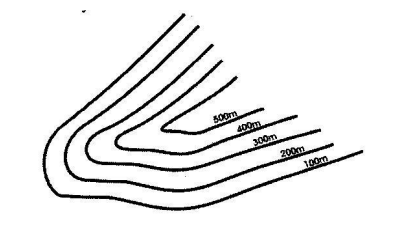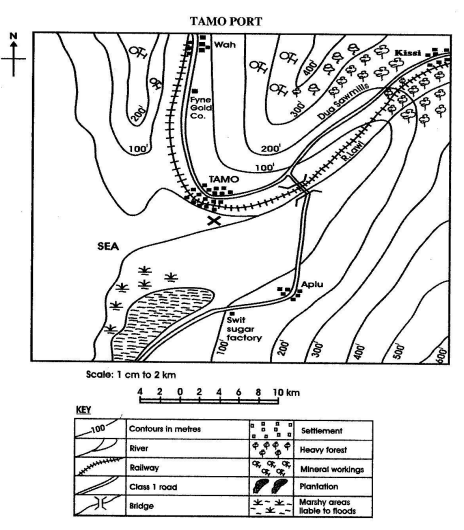1.
The colour used for showing rivers and lakes on topographical maps is
red
blue
brown
green
2.

Use the contour line above to answer the question below
The vertical interval is
100 m
200 m
300 m
400 m
3.

Use the contour line above to answer the question below
The landform shown is a
cliff
valley
ridge
plateau
4.
How many days does the earth take to complete its journey around the sun?
360 ¼
365
365 ¼
366
5.
6.
When it is 2:00 pm at a place on longitude 0°, the time at a place on longitude 45°W will be
10:00 am
11:00 am
12:00 noon
4:00 pm
7.
8.
Which of the following is not a coastal landform?
Cliff
Estuary
Sandbar
Lagoon
9.
10.
Use the table below, which shows the temperature and rainfall figures recorded for town A to answer the question below.
| Climate Months |
Jan | Feb | Mar | Apr | May | Jun | Jul | Aug | Sept | Oct | Nov | Dec |
| Temperature °C |
20 | 28 | 30 | 30 | 25 | 26 | 30 | 20 | 20 | 21 | 20 | 20 |
| Rainfall (mm) |
10 | 20 | 30 | 56 | 110 | 120 | 100 | 35 | 35 | 30 | 20 | 10 |
In which month was the highest rainfall recorded?
April
May
June
July
11.
Use the table below, which shows the temperature and rainfall figures recorded for town A to answer the question below.
| Climate Months |
Jan | Feb | Mar | Apr | May | Jun | Jul | Aug | Sept | Oct | Nov | Dec |
| Temperature °C |
20 | 28 | 30 | 30 | 25 | 26 | 30 | 20 | 20 | 21 | 20 | 20 |
| Rainfall (mm) |
10 | 20 | 30 | 56 | 110 | 120 | 100 | 35 | 35 | 30 | 20 | 10 |
The total amount of rainfall recorded for the year was
576 mm
607 mm
667 mm
706 mm
767 mm
12.
Use the table below, which shows the temperature and rainfall figures recorded for town A to answer the question below.
| Climate Months |
Jan | Feb | Mar | Apr | May | Jun | Jul | Aug | Sept | Oct | Nov | Dec |
| Temperature °C |
20 | 28 | 30 | 30 | 25 | 26 | 30 | 20 | 20 | 21 | 20 | 20 |
| Rainfall (mm) |
10 | 20 | 30 | 56 | 110 | 120 | 100 | 35 | 35 | 30 | 20 | 10 |
The annual range of temperature was
10 °C
20 °C
21 °C
25 °C
30 °C
13.
Which of the following statements best describes the position of Ghana?
Ghana is to the east of the Republic of Togo
Burkina Faso is the southern neighbour of Ghana
Ghana is to the immediate west of Niger
Ghana is to the immediate east of La Cote d‟Ivoire
14.
15.
The hot dry winds that blow over most parts of Ghana during the harmattan are the
south-west monsoon
south easterly winds
north-westerly winds
north-east trade winds
16.
The most important export commodity for Ghana is
timber
cocoa
coffee
pineapple
17.
Which of the following minerals is not mined in Ghana?
Gold
Diamond
Tin
Manganese
18.
The main cause of the formation of the Volta Lake was the
construction of a dam across the Volta River
generation of hydro-electric power from the Volta River
activities of the fishermen along the Volta River
construction of a bridge across the Volta River
19.
20.
The most popular mode of transport in Ghana is by
sea
rail
air
road
21.
All the big textile factories in Ghana are located at
Tamale
Winneba
Tema
Kumasi
22.
23.
Which of the following is not associated with celebration of festivals in Ghana?
Planning Developmental Projects
Cleansing Ancestral Stools
Feasting and Merry-making
Paying homage of chiefs
24.
25.
The Mamprusi in Ghana are believed to have come from
the Upper East Region
Western Region
southern Ghana
eastern part of Lake Chad
26.
The Accelerated Development Plan of education was introduced in Ghana in 1951 for the following reasons except
reduction of primary school education to six years
setting up many teacher training colleges
reduction in the number of job opportunities for school leavers
helping of some workers study privately to enter universities
27.
The second Republic of Ghana covered the period
1957 to 1960
1960 to 1966
1966 to 1969
1969 to 1972
28.
29.
Who was the chairman of the Center for Civic Education in Ghana?
Dr K.A. Busia
Mr Kojo Botsio
Dr John Bilson
Mr A Casely-Hayford
30.
The 1979 Constitution of Ghana was the
first after independence
second after independence
third after independence
fourth after independence
31.
Trade between two countries is called
barter trade
surplus trade
domestic trade
multilateral trade
32.
Which of the following Educational Policies emphasized the education of the girl-child in Ghana?
Education Act of 1961
Education Act of 1951
FCUBE of 1996
Education Reforms of 1987
33.
Most of the lakes in East Africa were formed as a result of the
rift valley system
fold mountain system
action of volcanoes
action of wind
34.
There is a large population of white settlers in the highland areas of East Africa mainly because
of the beautiful natural scenery
it is safe to travel along the steep slopes
of the sunshine and warmth
of the availability of water
35.
Which of the following African countries is a leading producer of cotton?
Kenya
Malawi
Egypt
Zambia
36.
Cotton is the raw material used in making
paper
clothes
shoes
cigarettes
37.
All the following are metallic minerals except
bauxite
copper
gold
diamond
38.
In which of the following countries is the system of apartheid commonly practiced
Egypt
Mauritania
Kenya
Nigeria
39.
40.
The UNO has all the following aims except
maintenance of international peace and security
development of friendly relations among nations
removal of unpopular heads of states of member countries
solving international problems
Use the map of Tamo to answer Question 1

a)
What is the direction of Kissi from Tamo?
b)
Calculate the distance in kilometres along the class one road from Aplu to the bridge across River Lawi
c)
What is the direction of flow of River Lawi?
d)
Name the feature marked X at the mouth of River Lawi
e)
Mention the main two lines of communication of the area.
f)
Using the map only, name two products that are likely to be exported through the Tamo port.
a)
Name three types of rainfall
b)
With the help of a diagram describe how any one type of rainfall is formed.
a)
Mention four qualities that made Osei Tutu a good ruler of the Asantes
b)
What three things did Osei Tutu do to keep the Asantes united?
a)
Mention four sources from which fish are caught in Ghana.
b)
Describe two ways by which the fish are caught.
c)
Name:
i)
two types of fish caught.
ii)
two methods of preserving fish.
a)
What was the major activity which brought foreigners into West Africa?
b)
What four effects did the coming of the foreigners have on the lives of the people of West Africa?
a)
Mention five achievements of the Aborigines Rights Protection Society (A.R.P.S)
b)
Give five reasons why the Aborigines Rights Protection Society collapsed.